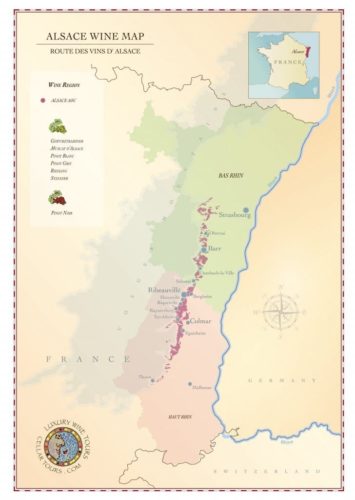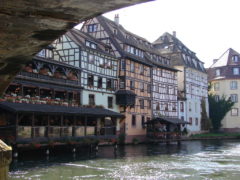Media: Introduction
The introduction lays out the central claims of the book and situates its historical, ethnographic, and theoretical interventions. It also provides necessary historical and contemporary background information on French politics, Manouches, and jazz manouche. Using the concept of ambivalent essentialism, I argue that ideologies of ethnoracial difference unfold dialectically with the development of jazz manouche.
Branding jazz manouche as Alsatian (p. 1)
Video 0.1: "Le Jazz Manouche, l'importance de la transmission !"
In the following video, you'll see and hear from musicians who are featured in Django Generations, including Marcel Loeffler, Biréli Lagrène, Cédric Loeffler, and Engé Helmstetter. This video is a news segment that originally aired on the regional television chain France 3 Grand Est; the video file is hosted on Marcel Loeffler's YouTube channel.
Several themes of the book converge in this video:
- The promotion of jazz manouche as closely tethered to the region of Alsace
- The simultaneous promotion of jazz manouche as an intergenerational, familial, and uniquely Manouche tradition
- Appeals not only to Django but to US jazz musicians as key musical influences (see chapter 3)
- Repetitions of the idea of “freedom” (sometimes with an explicit link between freedom and Manouche ethnorace)
- Distinctions between traditionally Manouche and institutional French (i.e. conservatory-centered) ways of understanding music
Note that the journalist erroneously states that Django “made jazz manouche known in the 1930s and 1940s” (see Chapter 1 on misunderstandings about the timeline and development of jazz manouche).
ENGLISH TRANSLATION
0:00: ANCHOR: Jazz manouche: the Zillisheim and Petite Pierre festivals prominently feature this traditional music that is transmitted orally from generation to generation, a music [that is] carried on within families, like in the Loeffler family. The accordionist Marcel Loeffler has just released his new album. So what is the status of jazz manouche in Alsace? [We go to] the response with [journalists] Anna Marie, Philippe Dezempte, and Valérie Ruiz Suri.
0:33: JOURNALIST: It’s his fourteenth or fifteenth album, he doesn’t even know anymore. Nine thousand concerts, a few struggles. At 63 years old, Marcel Loeffler, canonical accordionist in the Alsatian jazz manouche scene, plays his instrument with as much virtuosity as day one.
0:52: MARCEL LOEFFLER: We’re going to start with a first song, in fact, that’s called “Chocolate Mousse.”
0:57: JOURNALIST: [The] album [is an] anthology of the little treats in life, in the image of his familial music.
1:04: LOEFFLER: And my son Cédric, on guitar.
1:08: JOURNALIST: [The music is] joyful and also lively, always with an aftertaste of Django Reinhardt, the guitarist who made jazz manouche known in the 1930s and 1940s.
1:23: LOEFFLER: We always have this influence from Django, and that’s never going to disappear, thankfully. But also all the major jazzmen whom I’ve been able to listen to throughout my career, [such as] Charlie Parker, Miles Davis, Wayne Shorter — all these major [figures] really blew me away.
1:40: JOURNALIST: Django’s mother is of Alsatian origin, and the region boasts this plethora of his disciples. [They include] entire families of musicians who ensure the promotion of jazz manouche, but with complete freedom.
1:51: BENJAMIN RENNER (head of music programming at the Espace Django): Jazz manouche has difficulty finding a place in the professional world. By definition, Manouche music is rather a bit like the community, which is to say very [in the spirit of] nature [and] freedom, which is trickier in the administration of our cultural venues.
2:09: JOURNALIST: Biréli Lagrène, another local and virtuosic guitarist, has played on stages around the world with the biggest [musicians]. [He received a] Victoire de la Musique [the French equivalent of the Grammys] in 2001. His music falls more under [the categories of] classic or fusion jazz, but his origins are in jazz manouche, and his entire childhood in [the commune of] Soufflenheim.
2:27: BIRELI LAGRENE: I really had to say where I come from musically. I think that it’s still jazz manouche. My brother and I, we were fanatic about Django Reinhardt. As soon as I got home from school, we’d play very, very, very often, and a lot together. I parted ways a bit with [jazz manouche,] but I always re-enter the fray a little … It’s like a kind of battery that I have to recharge.
2:57: JOURNALIST: The shadow of Django [is] thus, still and always, also a family affair. Biréli Lagrène’s parents and grandparents were all musicians, like those of Marcel Loeffler. Jazz manicure is an oral tradition that is transmitted from generation to generation.
3:11: LOEFFLER: My father was the one who taught me. [When I was] 5 years old, he put a little instrument in my arms [on] Christmas evening. And it was a moment where I wasn’t feeling well, I think I must have had a little cold or something like that. And then, as soon as he put this instrument in my hands, I was practically cured, in fact.
3:41: JOURNALIST: Now it’s Marcel’s turn to teach his grandson Tagy, who doesn’t let his eyes leave his grandfather’s instrument. [Marcel is] also proud of his second cousin Tosca’s talent. She performs wonderfully this traditional Romani song, bringing together familial training and her classes at the Strasbourg Conservatory.
4:04: TOSCA HELMSTETTER: There is a more classical way of learning, so [there’s] vocal management, technique, and then there’s the side with [my] dad [Engé Helmstetter], and Marcel. That’s different because [our family members] teach us more about how to behave, how to inhabit the music and everything.
4:24: JOURNALIST: With the new generations, jazz manouche has a bright future in complete freedom.
PDF viewer
Promotional brochure issued by the official tourism organization Visit Alsace, advertising the Alsatian jazz manouche industry. The title translates as "Jazz manouche [is] at home everywhere in Alsace," and the text below: "[It is] impossible to stand still with this wild music that hits you in the gut and punctuates, [with its] red-hot notes, Alsatian days and nights. The homeland of jazz manouche is well and truly on this side of the Vosges [mountain range]."
Tunes referenced on pp. 2-3
Audio example 0.1: "It Had to Be You"
Tchavolo Schmitt (gui), Samy Daussat (gui), Costel Nitescu (vn), Claudius Dupont (db)
Link to video and chord chart
Audio example 0.2: "Blues en mineur"
Angelo Debarre (gui), Philippe Cuillerier (gui), Pierre Progoudine Gorsky (gui), Bernard Malandin (db)
Link to video and chord chart
Audio example 0.3: "Les yeux noirs"
The Rosenberg Trio - Stochelo Rosenberg (gui), Nous’che Rosenberg (gui), Nonnie Rosenberg (db)
Link to video and chord chart
Racial erasure (pp. 10-14)
Video 0.2: "The Celebration of the Gypsies: What is the Gypsy World Today?"
The following video is a French newsreel from 1946. It reflects some of the highly normalized racist, essentializing attitudes about Romanies that were commonplace in French society (some of which have barely changed in the intervening years). The video opens with footage from the annual Romani pilgrimage to the French village of Saintes-Maries-de-la-Mer in honor of Saint Sara. The narrator lists off various names for Romanies, some antiquated by today’s standards, in different countries. At 0:55, over images of Romani daily life, the narrator asks, “What are Gypsies? Where do Gypsies come from? We don’t know anything about them except their roulottes [wooden caravans], their part of the road, their solitude,” also claiming that “this race can figure out the secrets of life.” At 1:15, images of Romani children in school are accompanied by the narrator stating that “times are changing, the young Gypsies are going to school” and asking, “will the Gypsies decide to enter the circle of [mankind]?” Following this, the narrator notes an “astonishing thing, that a Gypsy is a student at the University of Paris. Even stranger, one has become an author and today is signing his first book.” (This unnamed person is actually Matéo Maximoff, one of the world’s most renowned Romani authors.) At 1:46, we see and hear Django Reinhardt, praised as someone who escaped “the crowd of his people” to reach his fame. The narrator concludes (1:57) that despite “these examples that are the sign of an evolution, the Gypsy people remains what it was yesterday, the people of roulottes, the people of the road, instinctive and mysterious, with its strange music and its eternal dances.”
Image 0.1: Carnet anthropométrique
Here, an example of a carnet anthropométrique (p. 13), the booklet that all nomades (considered practically synonymous with Romanies) were required to carry at all times. These booklets served as intranational passports and included detailed information about physical attributes such as skin color and skull size.

An example of a carnet anthropométrique. From the exposition “Mondes tsiganes: La fabrique de l'image” at the Musée de l'histoire de l'immigration, Paris, 2018. Image source: délibéré.fr


